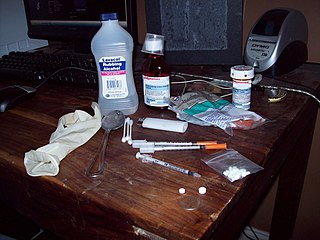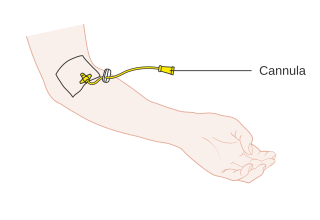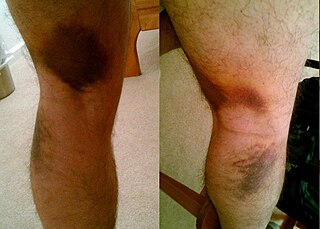
A blood cell is a cell produced through hematopoiesis and found mainly in the blood. Major types of blood cells include red blood cells (erythrocytes), white blood cells (leukocytes), and platelets (thrombocytes). Together, these three kinds of blood cells add up to a total 45% of the blood tissue by volume, with the remaining 55% of the volume composed of plasma, the liquid component of blood.

A blood-borne disease is a disease that can be spread through contamination by blood and other body fluids. Blood can contain pathogens of various types, chief among which are microorganisms, like bacteria and parasites, and non-living infectious agents such as viruses. Three blood-borne pathogens in particular, all viruses, are cited as of primary concern to health workers by the CDC-NIOSH: HIV, hepatitis B (HVB), & hepatitis C (HVC).

A cannula is a tube that can be inserted into the body, often for the delivery or removal of fluid or for the gathering of samples. In simple terms, a cannula can surround the inner or outer surfaces of a trocar needle thus extending the effective needle length by at least half the length of the original needle. Its size mainly ranges from 14 to 26 gauge. Different-sized cannula have different colours as coded.
In biology, hemostasis or haemostasis is a process to prevent and stop bleeding, meaning to keep blood within a damaged blood vessel. It is the first stage of wound healing. Hemostasis involves three major steps:
In competitive sports, doping is the use of banned athletic performance-enhancing drugs by athletic competitors, as a way of cheating. As stated in the World Anti-Doping Code by WADA, doping is defined as the occurrence of one or more of the anti-doping rule violations set forth in Article 2.1 through Article 2.11 of the Code. The term doping is widely used by organizations that regulate sporting competitions. The use of drugs to enhance performance is considered unethical, and is prohibited by most international sports organizations, including the International Olympic Committee. Furthermore, athletes taking explicit measures to evade detection exacerbate the ethical violation with overt deception and cheating.

In medicine, a joint injection is a procedure used in the treatment of inflammatory joint conditions, such as rheumatoid arthritis, psoriatic arthritis, gout, tendinitis, bursitis, Carpal Tunnel Syndrome, and occasionally osteoarthritis. A hypodermic needle is injected into the affected joint where it delivers a dose of any one of many anti-inflammatory agents, the most common of which are corticosteroids. Hyaluronic acid, because of its high viscosity, is sometimes used to replace bursa fluids. The technique may be used to also withdraw excess fluid from the joint.

Plateletpheresis is the process of collecting thrombocytes, more commonly called platelets, a component of blood involved in blood clotting. The term specifically refers to the method of collecting the platelets, which is performed by a device used in blood donation that separates the platelets and returns other portions of the blood to the donor. Platelet transfusion can be a life-saving procedure in preventing or treating serious complications from bleeding and hemorrhage in patients who have disorders manifesting as thrombocytopenia or platelet dysfunction. This process may also be used therapeutically to treat disorders resulting in extraordinarily high platelet counts such as essential thrombocytosis.
Prolotherapy, also called proliferation therapy, is an injection-based treatment used in chronic musculoskeletal conditions. It has been characterised as an alternative medicine practice.

Bone marrow examination refers to the pathologic analysis of samples of bone marrow obtained by bone marrow biopsy and bone marrow aspiration. Bone marrow examination is used in the diagnosis of a number of conditions, including leukemia, multiple myeloma, lymphoma, anemia, and pancytopenia. The bone marrow produces the cellular elements of the blood, including platelets, red blood cells and white blood cells. While much information can be gleaned by testing the blood itself, it is sometimes necessary to examine the source of the blood cells in the bone marrow to obtain more information on hematopoiesis; this is the role of bone marrow aspiration and biopsy.

Trimetazidine is a drug sold under many brand names for angina pectoris. Trimetazidine is described as the first cytoprotective anti-ischemic agent developed and marketed by Laboratoires Servier (France). It is an anti-ischemic (antianginal) metabolic agent of the fatty acid oxidation inhibitor class, meaning that it improves the heart muscle's ability to use glucose as a fuel by inhibiting its use of fatty acid metabolism. It has become controversial for its use as a performance-enhancing drug, with several scandals involving its use erupting at successive Olympic games.

A strain is an acute or chronic soft tissue injury that occurs to a muscle, tendon, or both. The equivalent injury to a ligament is a sprain. Generally, the muscle or tendon overstretches and partially tears, under more physical stress than it can withstand, often from a sudden increase in duration, intensity, or frequency of an activity. Strains most commonly occur in the foot, leg, or back. Immediate treatment typically includes four steps abbreviated as R.I.C.E.: rest, ice, compression, elevation.

A tear of a meniscus is a rupturing of one or more of the fibrocartilage strips in the knee called menisci. When doctors and patients refer to "torn cartilage" in the knee, they actually may be referring to an injury to a meniscus at the top of one of the tibiae. Menisci can be torn during innocuous activities such as walking or squatting. They can also be torn by traumatic force encountered in sports or other forms of physical exertion. The traumatic action is most often a twisting movement at the knee while the leg is bent. In older adults, the meniscus can be damaged following prolonged 'wear and tear'. Especially acute injuries can lead to displaced tears which can cause mechanical symptoms such as clicking, catching, or locking during motion of the joint. The joint will be in pain when in use, but when there is no load, the pain goes away.
Autologous blood therapy, also known as autologous blood injection or autohemotherapy, comprises certain types of hemotherapy using a person's own blood. There are several kinds, the original belonging only to traditional medicine, alternative medicine, and some newer kind of medicine under investigation. The original, unscientific form is "the immediate intramuscular or subcutaneous reinjection of freshly drawn autologous blood". It was used in the early 20th century, when some physicians believed that it had efficacy and a logical mechanism of action; it was abandoned as advancing science made clear that it lacked those.
Continuous erythropoietin receptor activator (CERA) is the generic term for drugs in a new class of third-generation erythropoiesis-stimulating agents (ESAs). In the media, these agents are commonly referred to as 'EPO', short for erythropoietin. CERAs have an extended half-life and a mechanism of action that promotes increased stimulation of erythropoietin receptors compared with other ESAs.

Platelet-rich plasma (PRP), also known as autologous conditioned plasma, is a concentrate of platelet-rich plasma protein derived from whole blood, centrifuged to remove red blood cells. Though promoted to treat an array of medical problems, evidence for benefit is mixed as of 2020, with some evidence for use in certain conditions and against use in other conditions.

Anthony Galea is a Canadian doctor who specializes in sports medicine and director of the ISM Health & Wellness Center Inc. in Toronto, Ontario.
Platelet-Poor Plasma (PPP) is blood plasma with very low number of platelets (< 10 X 103/μL). Traditionally, PPP was recommended for use in platelet aggregation studies to both adjust the platelet-rich plasma concentration, and to serve as a control. PPP may have elevated levels of fibrinogen, which has the ability to form a fibrin-rich clot once activated. Wound healing requires cell migration and attachment, which is facilitated by this fibrin clot.
The treatment of equine lameness is a complex subject. Lameness in horses has a variety of causes, and treatment must be tailored to the type and degree of injury, as well as the financial capabilities of the owner. Treatment may be applied locally, systemically, or intralesionally, and the strategy for treatment may change as healing progresses. The end goal is to reduce the pain and inflammation associated with injury, to encourage the injured tissue to heal with normal structure and function, and to ultimately return the horse to the highest level of performance possible following recovery.
The practice of doping in tennis involves the use of prohibited, performance-enhancing substances listed by the International Tennis Federation (ITF) and World Anti-Doping Agency (WADA). The practice is considered unsportsmanlike and unethical, with punishments for such offences ranging from official warnings to career bans, depending on the severity of the offence.











